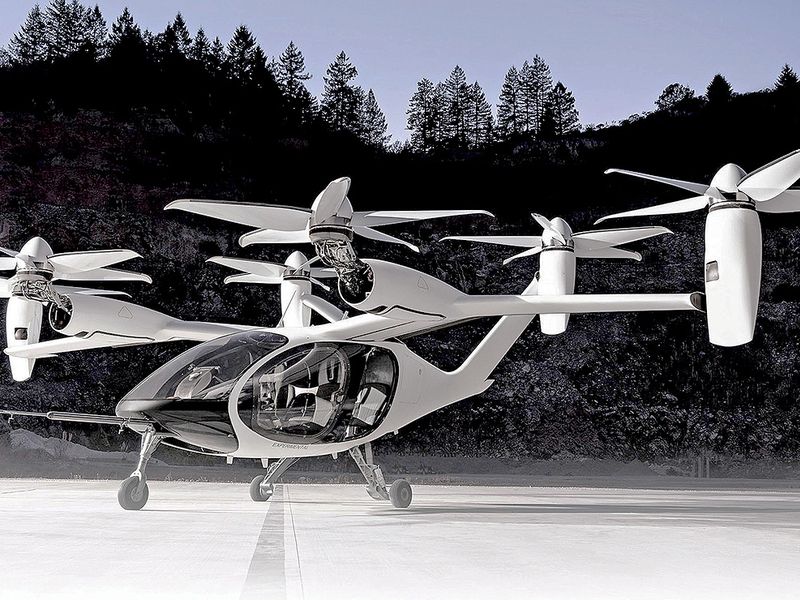
General Motors’ aspirations for its future-minded technologies are soaring sky high.
The company indicated last week that it will explore ways to branch beyond its traditional — and terrestrial — business and into aviation.
Flying taxis may be a mere glimmer on the transportation horizon today, but GM intends to explore ways to help make them an everyday reality.
Calling it a “natural next step” in GM’s vision for environmentally friendly transportation, CEO Mary Barra said the strength and flexibility of the company’s Ultium battery system “opens doors for many use cases, including aerial mobility.”
She did not elaborate on the comments, made while speaking to a group of investors at the virtual RBC Capital Markets conference last week.
Despite the lack of firm details, the comments were welcomed by some analysts and investors eager to see automakers examine the possibility of extending their experience in electrification, autonomy and connected services to other transportation modes. While others are more skeptical of the air-mobility future, Asad Hussain, mobility analyst at PitchBook, is bullish on the entwining of aviation and automotive.
“There’s a reason traditional auto companies are interested in this space,” he told Automotive News. “We believe innovation in battery technology spurred by electric cars will be central to electrifying the broader transportation space, including freight and aviation.”
GM is hardly the only automaker eyeing such a transition. Companies such as Toyota, Daimler and Geely have done more than hint at interest: They’ve invested in startups that are building prototype air taxis, which run the gamut from glorified helicopters to true “flying car” vehicles capable of being both street-legal and airworthy.
Urban air mobility could evolve into a $1.5 trillion market, according to an analysis conducted by Morgan Stanley, which said in the wake of Barra’s comments that it had “become obvious” that electric and autonomous air mobility had moved beyond the realm of science fiction and into the realm of reality.
“If we can operate a drone on a planet more than 30 million miles away,” the firm’s research analysts wrote in a note issued last week, “then how hard is urban air mobility in the skies above Dayton, Ohio?”
Perhaps more complicated than Morgan Stanley envisions.
In a September 2017 research paper titled “Flying Autonomous Vehicles –— The Next Big Thing That Isn’t,” Gartner analysts Kimberly Harris-Ferrante and Michael Ramsey wrote that high costs, safety concerns and regulatory burdens likely will limit the deployment of “this overhyped technology.”GM signals interest in air mobility, but will such projects fly?
Ramsey said last week there have been no developments in the ensuing three years that have altered his outlook that flying taxis — while they sound cool and may be utilized by a well-heeled, niche audience — have limited use in more widespread fashion, along with operational constraints.
One hindrance that could limit financial rewards associated with the electrification of air taxis: There’s a trade-off between battery weight, range and the payload, be it freight or number of passengers.
Further, flying taxis could lead to traffic congestion in the air above cities already seeking to diminish ground-based traffic snarls and strengthen their regulatory control of new mobility modes.
A business model remains far from certain. Voom, a helicopter taxi service backed by Airbus, launched in 2016, promising to democratize the skies.
It shuttered in March 2020, citing operational challenges related to infrastructure, public acceptance and the intricacies of on-demand vs. scheduled services — not to mention COVID-19 travel disruptions.
Another prominent aviation-industry player reduced its urban air-taxi footprint last week, just one day after Barra hinted at a role GM may play in air mobility.
Boeing suspended operations at Boeing NeXt, its 2-year-old innovation division that had been exploring unmanned and piloted air-taxi applications.
Still, investments in vertical-takeoff-and-landing aircraft, known commonly as VTOLs, could reap gains that make services tailored to urban areas more efficient and financially feasible. The World Economic Forum, a global think tank, says urban air mobility will “likely” be commercially viable by 2028 if policies and regulations evolve to encourage further growth and investment.
Last week, the forum issued a report called “Principles of the Urban Sky,” which is designed to help cities navigate issues ranging from airspace control, traditionally the realm of the federal government, to noise sensitivity and equitable access to aerial transportation.
Logistical, operational and safety challenges ensure an uncertain takeoff for the embryonic market. But a status quo of worsening traffic brings its own challenges, said Jim Adler, managing director at Toyota AI Ventures, the automaker’s venture capital arm which has invested in air-mobility startup Joby Aviation.
“You can’t go down and build a lot of tunnels; it’s too hard,” he said last November. “Hyperloop, Big Dig, it doesn’t work. You can’t build more roads, at least in most cities. So where are you going to go? You’ve got to go up, right?”